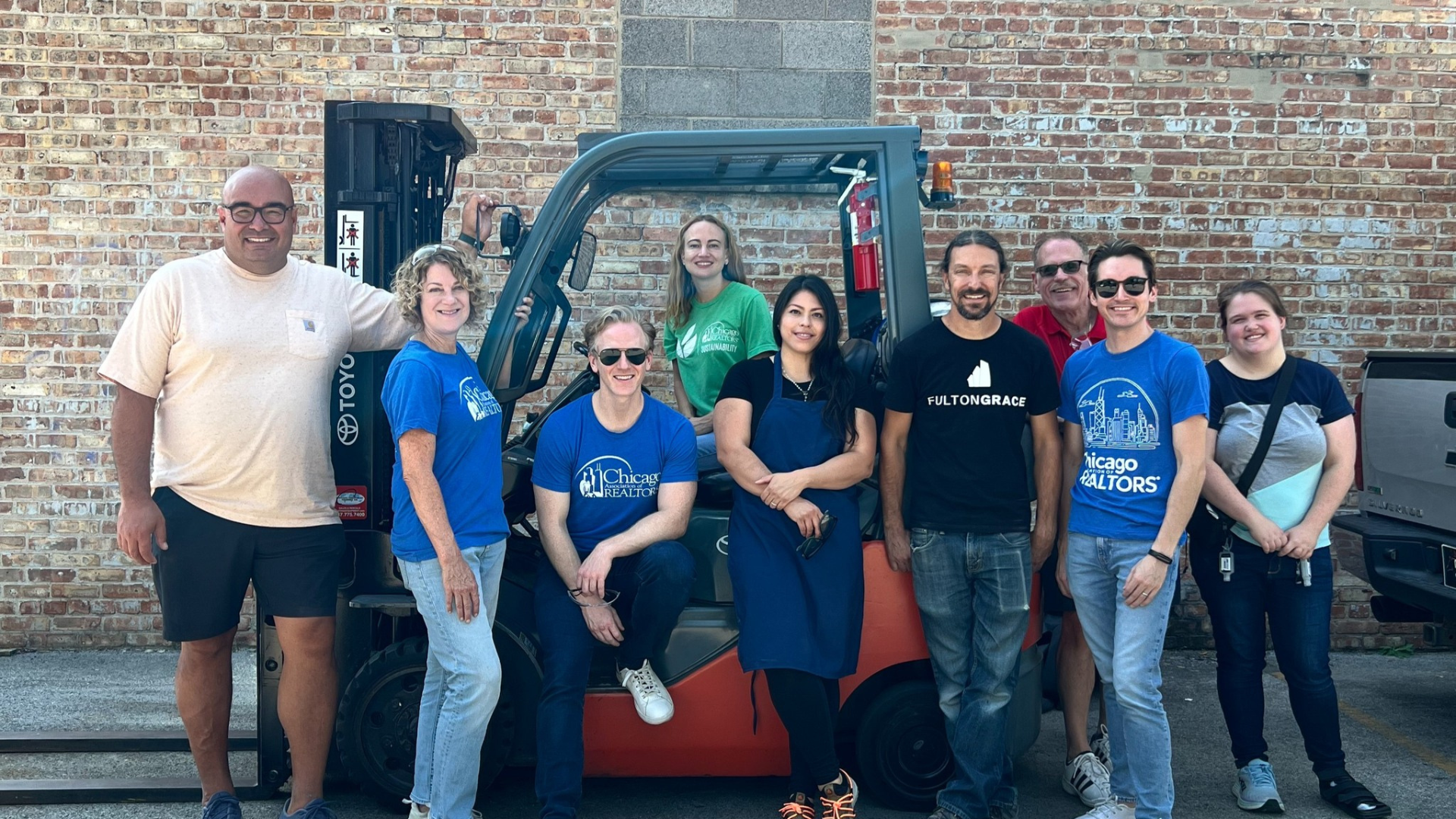The Chicago market has seen a steady decrease in inventory that has gained steam over the last four years, hitting its lowest in December 2023 with just over 4,500 homes for sale in the city of Chicago. In this competitive sellers’ market, it’s vital to have strategies in place to find seller clients and develop strong listings that create buyer demand and competitive offers.
In April, our Young Professionals Network invited three dynamic seller’s agents, Melanie Everett, Melanie Everett & Co., Donna Manella, CENTURY 21 Circle, and Chih-Hao Yang, Fulton Grace Realty, to share their strategies and tips for listing success.
A great way to approach the listing process is to break it up into four steps: attracting leads and expressing your value, pre-listing work, active listing to contract and closing preparations and, finally, post closings.
Attracting Leads & Expressing Your Value
How do you generate leads of seller clients?
Everett knows there is merit to a long-term strategy. Over the last 10 years, she has built a database of buyer leads and clients. Although she now works with both buyers and sellers, Everett previously focused on the buyer side of the transaction through teaching the course, “So You Want to Buy a Condo,” which she still teaches today.
Through trusted relationships and consistent communication, those buyers have become her and her brokerage’s best source of referred leads or repeat clients when they were ready to sell. And
following the success of her buyer class, she added a sister class, “So You Want to Sell A Condo.” She treats her database of course attendees as hot leads that turn into seller clients.
Beyond these courses, Everett successfully connects with seller leads by getting involved in her neighborhood of Lincoln Park. As a boutique brokerage, she finds that it can be hard to get Melanie Everett & Co.’s name out there, so she started sponsoring local events, like face painting booths at block clubs or wine strolls to get her name and logo additional exposure.
Manella built a successful pipeline through word of mouth. “Every single buyer I worked with, I would end up having them be my spokespeople in order to get those sellers. They would talk to their friends, their families, their coworkers,” she said. Beyond just word of mouth, she uses an automated system to send out a survey at the end of a transaction to ask for feedback from each client.
Manella, who also served in the United States Coast Guard, uses her connection with her military groups and volunteer opportunities as a way to generate seller leads without selling herself as a REALTOR®. She showcases her work ethic through her commitment, accountability and trustworthiness as a volunteer and brings those qualities to her work as a REALTOR®.
That commitment, combined with the fact that her fellow volunteers know she’s in the real estate business, inevitably leads to questions and conversations about the real estate market, and she is always ready to showcase her expertise. If the conversation of buying or selling comes up organically, Manella offers her services as an expert resource.
Yang echoed the importance of connections and of knowing your audience. He uses his experience as an immigrant to connect with potential leads and posts videos about the Chicago homebuying experience in both English and Mandarin. He estimates that about 80% of his sellers reach out to him after seeing his social media videos.
Yang makes and remakes the following evergreen videos for a consistent content schedule:
- The Homebuying Process From A-Z
- How to Walk Through A Condo Listing & What to Look For
- (With the Client’s Permission!) A Room-by-Room Walkthrough of His Own Listings
Post the videos on Instagram, Facebook, TikTok and YouTube for maximum exposure. If you’re worried about running out of ideas, re-center yourself with this question: who do you want to work with, and what kind of questions will those people want to ask their potential REALTOR®?
The Listing Presentation Process
For Everett, her pre-listing work begins with a multi-step process that was adopted and honed during the pandemic. Your listing presentations don’t have to be in person! Zoom ended up being her team’s preferred format because of how easy it is to share a screen and present a branded slide deck.
Here’s how the process works:
- When a lead reaches out to her and her team, they are sent a seller’s guide and schedule an introductory call.
- Her team has a consultation call, where they discuss their timeline, goals, questions and compensation.
- Next, they go to their lead’s home and do a walk-through to get to know the seller and the property. This is the time they can start building a relationship and trust with their clients.
- Then, they create a multi-page pricing recommendation that provides their honest insights on the property and a price range for the property. It cites their sources with CMAs.
- Her team presents their plan for the listing, outlining how they would market it and what working with them would look like. They use the insights they gleaned from the introductory call and the property walk-through to personalize the presentation.
- From there, they put the ball in the lead’s court to decide if they” would like to work together.
“I think our vision is to make the seller really trust us and like us because of how detailed we are, how thorough we are and how good of listeners we are,” Everett said.
Pre-Listing Work
Doing Your Research
Once you have the listing agreement complete, it’s time for the pre-listing work. Manella begins by sitting down with her client and educating them on the factors of their home that are important to buyers, which she credits having knowledge on from taking the Accredited Buyer’s Representative (ABR) Designation course.
She walks through the entire interior and exterior with her client, looks at systems and discusses their age, and does a deep dive into the areas she knows a buyer will have questions about when viewing the home. If she suggests any maintenance should be done, she works with her client to have it complete before the listing hits the market.
From there, she double-checks all the information she has gathered against government documents, like the treasurer’s and assessor’s websites, to check for accuracy. She checks for any city code violations, which, she says, will kill a deal faster than anything else. All this information goes into a packet given to buyers’ agents.
If you don’t feel confident in your listing knowledge because you’re newer to the business, use your existing experience working with buyers. You know a lot more than you may initially realize.
Posting the listing on the MLS comes next. Manella encourages everyone to take educational courses on how to effectively use the MLS and input all the information correctly. “If you don’t have that information, you’re missing opportunities. Every single thing in that MLS sheet is a searchable field, so we want to make sure that we know every single field, and what it really means,” she said. This will help your listing get in front of the correct buyers.
Yang echoed the importance of utilizing the MLS to its full potential. “I mostly do condos in the city and one of the biggest issues I see is that the unit has in-unit laundry, but the seller agent is not entering that in the MLS under appliances or internal features. And most of the buyers are filtering that unit out right away,” he said.
MRED offers free training courses that go over the dos and don’ts of submitting listing information into the MLS. A list of classes can be found at training.mredllc.com.
Branding the Listing
For Everett, one of the most exciting parts of listing the property is the branding. Once a listing agreement is signed, their staging and design partner is sent in to meet with the sellers independently. Everett finds that staging and design suggestions can come off wrong if they come from the agent, so she lets her partner take the lead in providing that feedback to the seller. Once the designer’s suggestions are made, their photographer comes in to take photos.
Then, Everett takes the time to craft the home’s story. “What that looks like is really painstakingly writing that listing description and making sure it’s as transportive as possible,” Everett said. The listing’s description not only captures that home’s lifestyle but also showcases her brokerage and the value they’re providing their client.
Manella also addressed the importance of floor plans in a listing. “I’ve been told that my photos and floor plans ended up being the benchmark where the buyer would go around, look at the competition, and say, ‘You have bigger bedrooms.’ ‘Did you realize the other places that are priced the same as you don’t have a separate dining room?’ [Floorplans] will help you market your property even when people aren’t in your property,” she said.
Yang finds that Matterport, combined with floor plans and walk through videos work best for his audience of out-of-state buyers that might not be able to see the unit in person before the purchase.
Active Listing To Contract
Showings
When it comes to showings, every seller’s agent approaches it differently.
Yang leaves the decision to his seller on whether or not they want him to be present. “I also explain to them that buyers and buyers’ agents sometimes might not want me to be there. They want to be left alone so they can talk about the property, so they don’t feel like I’m watching them,” he added.
Manella has packets ready with the MLS listing sheet, all disclosures, photos and floor plans to distribute to buyers and buyer agents. She also provides a printed multi-board contract ready, so if a buyer wants to write one, they can do so immediately.
If the house is occupied, she goes over safety protocols with her seller, including putting away cutlery and knives, hiding medications (even removing them from closed bathroom cabinets!) and valuables, and, if she’s working with a veteran or active military personnel, to lock those gun safes.
Open Houses
For Everett, open houses are a big part of the listing strategy. Her and her team treat open houses like parties – everyone gets dressed up, they play a playlist, serve cold beverages and set up marketing throughout the property. For example, she may get foam boards on stands that depict virtual staging what-ifs of the rooms.
“I think open houses are very important, not just for showing a property and selling houses, but also for marketing yourself and your brokerage, and showing people what you can do,” she said.
What To Do If There’s Little Activity on A Listing
So, what do you do when you have to revisit your listing strategy due to little activity?
Yang collects feedback from every buyer who tours his listings. After a showing or open house, he emails a brief survey to the buyer’s agent. If he doesn’t get an immediate response, he texts them the next day.
All feedback is shared with his sellers, keeping the chain of communication open. “No feedback can be good feedback,” he added.
Manella sends every seller a periodic comparison of market value to show her client what’s happening in the neighborhood and similar property types. This gives her something to point to if they need to do a price correction on the property; although the price is at the seller’s discretion at the end of the day. She also sets up automatic feedback on ShowingTime to find common denominators in what needs to be adjusted.
“If your property is overpriced, all you’re doing is selling other people’s listings,” she cautioned.
Closing Preparation & Post Closing
Once an offer is accepted, it’s time to begin the closing process.
Manella keeps herself organized by putting everything in her phone as a calendar appointment, including the timeline, when the insurance is due from the buyer and when the loan commitment is due.
Because most of his sellers are not local, Yang keeps his sellers up to date on the closing process through constant communication. He tells them the day and time the inspection will be taking place and then goes through the inspection report with them via email. This also allows him to let the sellers know if there are any issues that arise that could delay the closing.
All three REALTORS® emphasized the importance of asking for feedback from their sellers once the closing has finished. Manella, for instance, has an automated system in place to ask her clients for feedback the day after they close. “I work very hard to keep those ratings high because I know that buyers who are becoming sellers at some point, or sellers who are selling again, look at those ratings,” she added.
And congratulations! You’ve officially closed on your listing.
As you navigate your own listing processes or prepare for your very first, your value ultimately comes down to how organized and consistent your systems are and how well you communicate what you do.
Dedicate time to write out a step-by-step process for each of the four above “phases” to listing a property. Review these processes constantly and identify where you can templatize and where you can personalize. The time spent taking classes like the ABR Designation or MRED training is time spent on making yourself a stronger advocate and a trusted advisor for your clients.










